February 13th, 2014

Enjoyed tweeking this free unison choir arrangement of “‘Tis So Sweet to Trust in Jesus”.I wrote it sometime ago for one of our pianists to play for choir while I was out of town.
One improvising tip to take note of (no pun intended)…is when I left out the melody here and there in the piano score.
Most of the time this occurred was when the melody note was an eighth note…making for a smoother form of playing for the church pianist. Skipping a quick melody note in the piano accompaniment is similar to the “understood you” in a sentence. You know what’s implied even though you don’t hear it. 😉
I just played it straight through without repeats. (two verses and choruses)
Click on audio below to hear the entire free unison choir arrangement of “Tis So Sweet to Trust in Jesus”
You need to have the Audio Player Plugin installed to use this shortcode
Click here to download: “Tis So Sweet to Trust in Jesus”
Tip: This choir arrangement can also be used as a vocal solo.
Tags: church pianist, free arrangement, free unison choir arrangement, tis so sweet to trust in jesus
Posted in Accompaniment tips, Choir, Free music, Improvising hymns, Miscellaneous tips, Special Music, Vocal | 8 Comments »
February 12th, 2014

I’m re-organizing my music at home and came across a simple unison choir arrangement of “Tis So Sweet to Trust in Jesus”.
I wrote it for one of our pianists to play for choir while I was out of town a good while ago. This particular pianist was probably an early intermediate at the time and needed something basic to accompany the choir for this particular hymn.
I hope to share this free arrangement with you tomorrow..IF we still have power…in the middle of a snowstorm! (You can also use this free choir arrangement as a vocal solo too).
Tags: free choir arrangement, tis so sweet to trust in jesus
Posted in Accompaniment tips, Choir, Free music, Special Music, Vocal | 1 Comment »
February 6th, 2014
Here’s the video of me playing my (free) piano hymn arrangement of “The Old Rugged Cross” for the recent Hymnplaying Master Class held at The Wilds Music Conference. (December 2013)
I received helpful critique! Thanks to Faye Lopez and Duane Ream for their constructive advice. I look forward to improving my hymn arranging through any learning opportunities I can find! (The harmonic structure tips were things I knew to do but just hadn’t noticed them in the piece.)
I couldn’t believe I left a melody note out in the original arrangement on measure #18 (meas. #16 in revised version)…I”m a stickler for following the words as I play but my mind must have been on another verse….so embarrassing to have such an error 🙁 Duane made SURE I saw that error 😉 Seriously, I appreciated the emphasis he made on keeping the melody CLEAR..after all….it’s the message we try to convey as church pianists…right?
I’m posting the (graded/corrected) copy of the arrangement below the video for ease of reference. The red squares throughout the arrangement notate the changes. Most of the changes were from the suggestions made on the video. (My personal note changes are in measures: 20, 24, 38, 40 and 48.)
You can download the new pdf of “The Old Rugged Cross” (minus the grading marks)…at the bottom of this article.
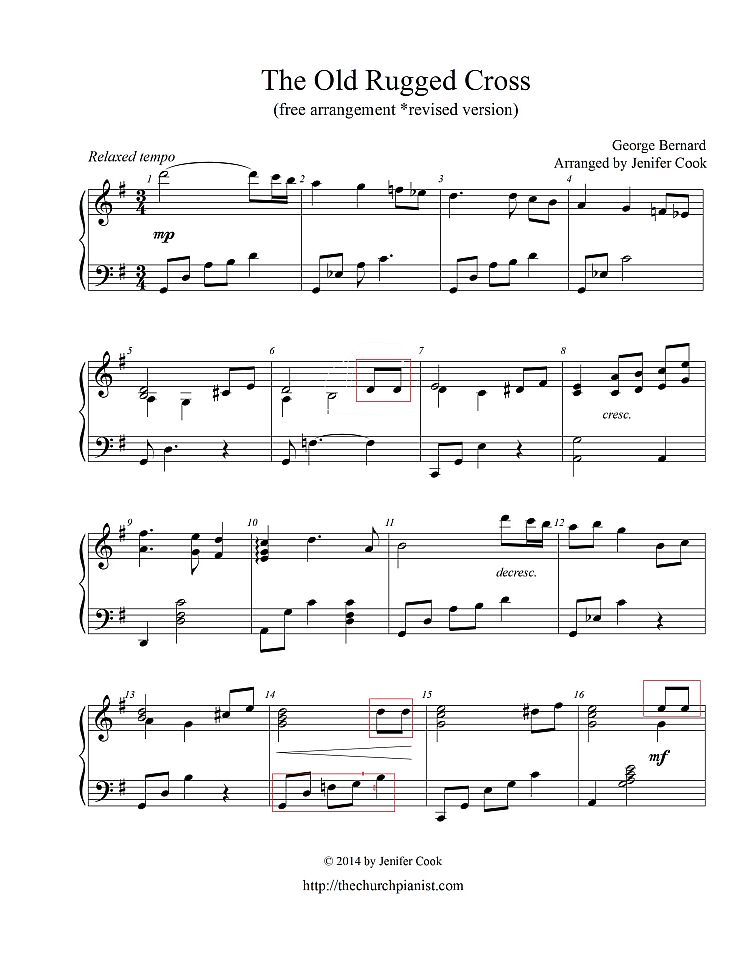
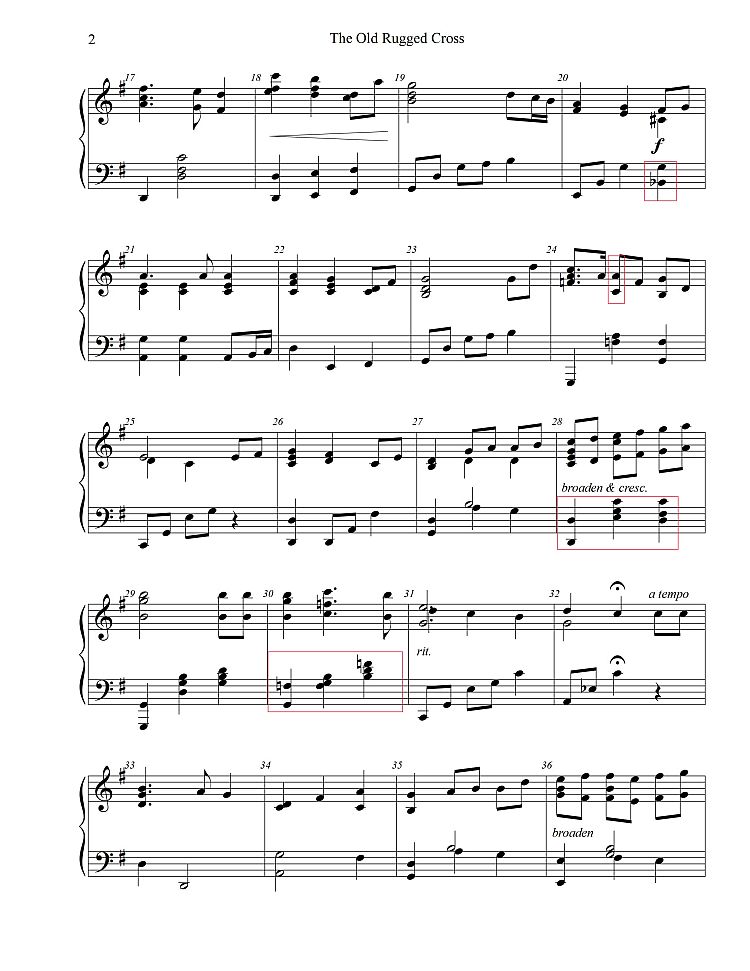
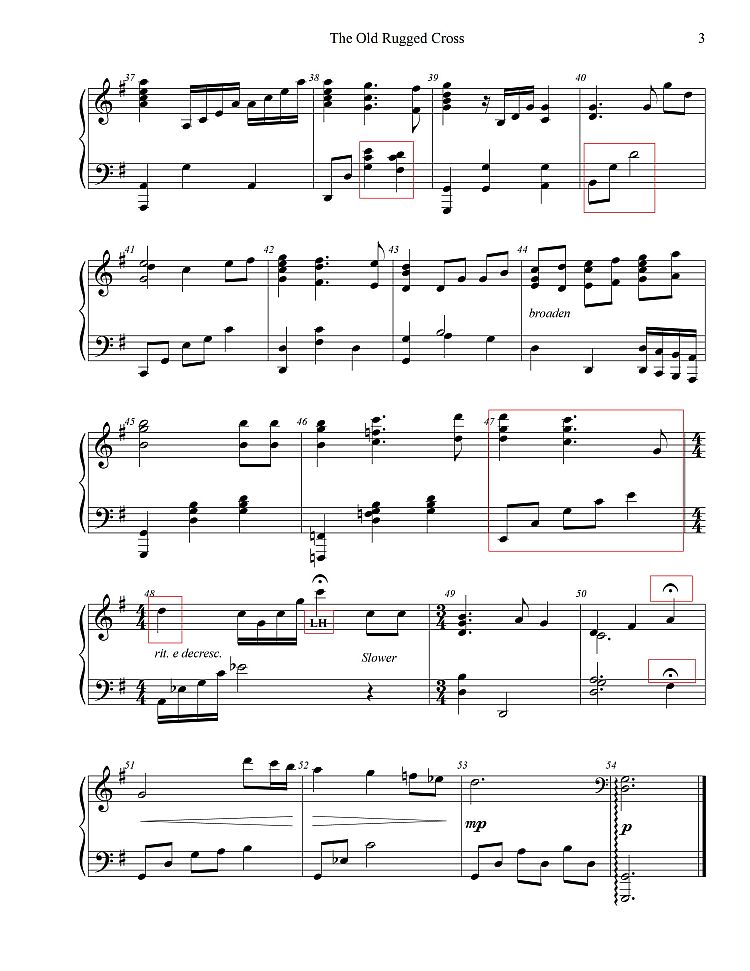 Click here to print: The Old Rugged Cross (revised)
Click here to print: The Old Rugged Cross (revised)
Tags: free piano arrangement, hymn playing master class, old rugged cross, Wilds music conference
Posted in Accompaniment tips, Improvising hymns, Miscellaneous tips, Offertories, Special Music, Theory, Videos | 11 Comments »
February 4th, 2014
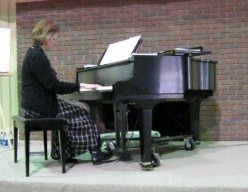
The next post will be a video of me being critiqued in Hymn Playing Master Class at the recent Wild’s Music Conference.
Just don’t feel sorry for me 😉 We all need a work over at times!
I played my free piano arrangement of “The Old Rugged Cross” for this class. So…you may want to have a copy of it handy during the video for reference.
Before you click to download your free copy of The Old Rugged Cross, you may want to wait until I provide the edited version based on the critique I received in this Hymn Playing Master Class. It’s all up to you.
Click here to print your free copy of “The Old Rugged Cross”. (original version)
Tags: free piano arrangement, hymn playing critique, hymn playing master class, the old rugged cross
Posted in Accompaniment tips, Chords, Improvising hymns, Offertories, Special Music, Theory | 3 Comments »
January 30th, 2014
♫ Chord Substitution ♫
Replacing the V7 with a ii7
Chord substitutions work best when enough time is allowed. For example, when a V7 chord lasts for two or more beats…there’s time to replace it with a different chord. The ii7 can replace the V7 and still resolve back to the original (V7) chord.
For example, in the key of C Major…the V7 is GBDF and the ii7 is DFAC
In the following examples, the hymnal version is displayed along with the improvised version showing the substituted chord.
I did not label the V7 chord in the hymnal version of each example that lines up with the substituted chord in each improvised version. I will tell where they occur:
It is Well…on the syllables “tend-eth my” and for Just As I Am…”-out one” (before “plea”)
*Keep in mind…I’m using the same sheet as I did in the previous lesson on chord substitutions for the I chord.
The ii chord substitution is hand-written in red under the measures with a red square around them. I also labeled the V7 chord under the red square examples so you could see where the ii7 resolved back to the V7.
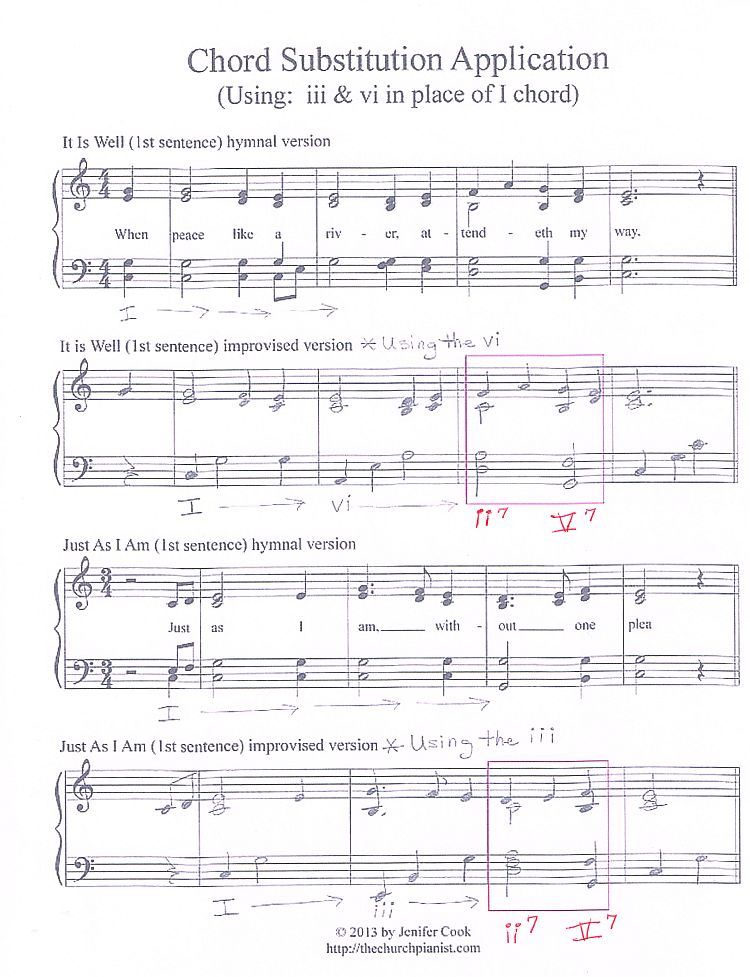
Tags: chord, chord substitutions
Posted in Accompaniment tips, Chord Substitutions, Chords, Improvising hymns, Theory | 2 Comments »
January 21st, 2014

Please pray for my son and daughter-in-law as they just had their second miscarriage in the past three months.
The picture above was taken of them this past Christmas with their precious son… whom I’m watching this week.
My next article will probably be next week.
Appreciate the prayers.
Posted in Uncategorized | 8 Comments »
January 14th, 2014
I wasn’t brave enough to play the first day of Hymn playing Critique Class but…thanks to Mike Haynes, a sophomore in high school, who played his arrangement of “Count Your Blessings” for critique…providing a platform of learning for all of us!
I thought Faye Lopez and Duane Ream gave some excellent suggestions to Mike.
Enjoy the video below. (I apologize for my amateur recording but felt the content worthy of sharing regardless of the quality).
Tags: duane ream, faye lopez, hymnplaying class, Wilds music conference
Posted in Accompaniment tips, congregational singing, Improvising hymns, Miscellaneous tips, Offertories, Theory, Videos | 1 Comment »
January 7th, 2014
This will be one of several videos I’ll share from my recent trip to the annual Wilds Music Conference. I had not planned on videoing the sessions…thinking they were being done by someone professionally. So…you will have to put up with my amateur recordings 🙂 The first part of Hymnplaying Master Class on Tuesday consisted of an open discussion on the benefits of piano duets…even with a few composer tips from Faye and Duane on writing quality piano duets. I’ll start with the benefits of playing piano duets: *Allows time to focus on basic techniques with easier playing passages…such as phrasing, pedaling, dynamic balance between two players, etc. *Prepares pianist to think and play like an accompanist. For example, both pianists have to keep melody dominant throughout. The pianist without melody part must remain in the background (so to speak)…allowing the melody to be heard. *Playing piano duets can improve the pianist’s sense of rhythm. Teaches them to play different rhythms against the other player. Such as: one pianist may play triplets while the other is playing straight eighths. (fun! fun!) The pianists are forced to play the correct rhythm if they are to stay together. *Encourages teamwork!
Now…on to several composer tips in writing piano duets:
*Stack duet parts on one page so both pianists are aware of the full picture. *Try the duet with another pianist to check for hand collisions (I speak from experience on this one) 😉 *Avoid writing in excessive extreme registers (real low or high). Too high gives the primo a “tinty” or “empty” sound. Writing primo section more near the middle of the piano gives the piece a more balanced, pleasing tone. Playing too low will give the duet a “cloudy/muddled” tone.
Piano duets on this video:
O Come All Ye Faithful from: “O Come All Ye Faithful” by Nathan Arnold
I Need Thee Every Hour from: “Standing on the Promises” by Nathan Arnold
Saved! Saved! from: “Like a River Glorious” by Rebecca Bonam
Dwelling Beulah Land from: ? (I think it was a Rebecca Bonam duet…not sure)
Other Piano Duet Book List:
Immortal Invisible by Dan Forest
Crown Him Lord of All by Dan Forest
Joy to the World by Rebecca Bonam (piano solo book with three duets!)
Tip: Don’t forget those duets in the back of your piano solo books you may have 🙂
*The above book titles are clickable links that carry you to BJU Press. However, these books are no longer available through BJU Press. Go to Lorenz to purchase them. (or try Ebay or Amazon)
Tags: benefits of piano duets, pianist, pianists, piano duets, Wilds music conference
Posted in Accompaniment tips, Composing, Music Book or CD Reviews, Offertories, Special Music, Technique, Videos | 6 Comments »
January 4th, 2014

After wanting to go to the Wilds Music Conference for at least the past ten years….I finally got to go! My schedule just didn’t allow it in years past since the conference was scheduled at the end of December and into New Year’s Day. ( I believe the Wilds is changing the music conference to a later date next year….to sometime in January.)
Please understand that this conference is a general music conference. Since it’s only about a 2 & 1/2 hour drive…I felt it was worth attending. Read the conference description below as stated on The Wilds website:
“Join us for the mixture of general preaching sessions, biblical philosophy and practical “how to” workshops, and choral reading sessions which will make you more effective in your ministry of music in your local church. Both trained musicians and laymen alike will benefit from the blessing and refreshment of fellowship around Christ-honoring music at this conference.”
Here’s what I did at the conference:
* Hymnplaying master class (once a day for three days) great practical ideas for pianists in general!
* Attended at least eight Choral reading sessions (free pack of music per session)
* Rubbed shoulders with musician friends (always pick up ideas from fellow musicians!)
* Went to Sacred concert by Matt & Christy Taylor on Wednesday evening
I do plan on sharing my gleanings in future posts. The highlight of my week was playing in the Hymnplaying master class for critique. What constructive advice I received! (will share in video soon!)
Tags: Wilds music conference
Posted in Uncategorized | 1 Comment »
December 27th, 2013
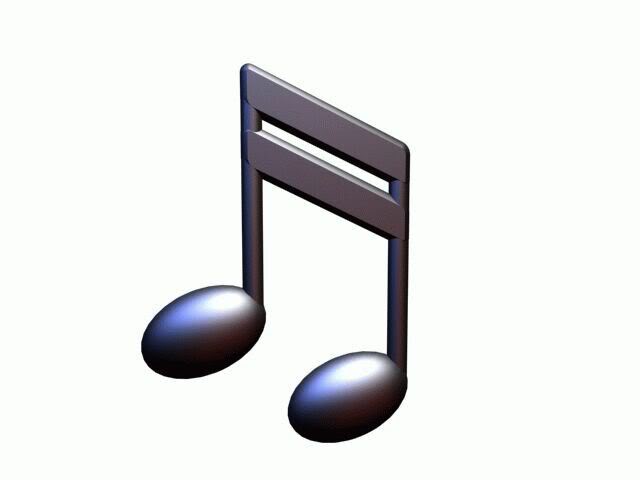
Answers from previous quiz questions for Chord Substitutions:
Minor chords for IV are ii and vi
Minor chords for V are iii and vii
Key of C Major: F chord is the IV chord….so…d minor is the ii chord and a minor is the vi chord. The V chord is G….so….e minor is the iii chord and b minor is the vii chord.
Review from last lesson: A Major chord lasting two or more beats can be substituted with a minor chord. Go up or down two chords from the Major chord to find its minor chord substitutions.
For example: The C Major chord can be substituted with an e minor or a minor chord. (The melody note dictates which substitution will sound right).
This is only the beginning…there are SO many chord substitutions! I’m just covering the basic choices.
New Lesson
Warning label to the church pianist: Chord substitutions cannot be used for congregational singing IF the congregation is singing parts from hymnal.
Chord substitutions can be used for solo instrumentals or when accompanying vocalists or instrumentalists singing or playing the melody.
Reason for selective use: chord substitutions do not support the written voice parts in a hymnal.
Our church has a small congregation that mainly sings melody with occasional tenor….giving me more freedom in congregational accompaniment. Adding chord substitutions just brings what would be a plain hymn…to life!
If you’re a church pianist wanting a warmer sound to your playing…chord substitutions are the answer! I use a lot of chord substitutions during invitation..creating a more reflective mood. Our pastor likes background music during the entire invitation…allowing me more freedom to alter the melody and chords.
The following chord substitutions would be better understood if the church pianist had a basic understanding of being able to analyze chords within a hymn…hence….another lesson in the works 🙂
Until then…enjoy learning a couple chord substitutions for the following hymns.
Layout explanation: Three different hymn examples; each hymn is represented by an original line from the hymnal followed by an improvised version of that line. The I (CEG) chords are labeled as well as the substituted chord numbers. Each example is in C Major. *Measures marked with a red square require future post to explain.
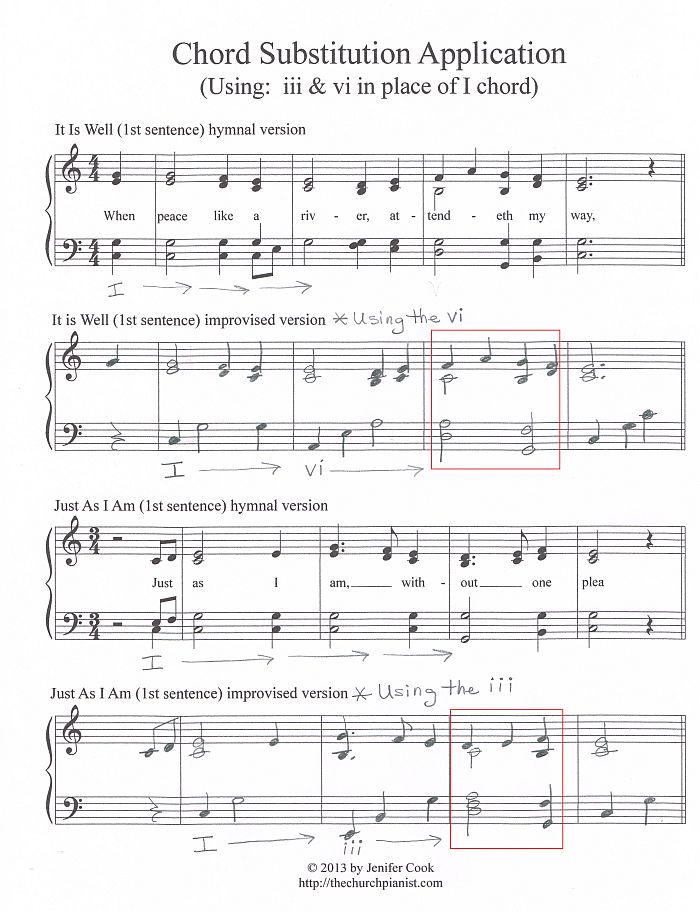
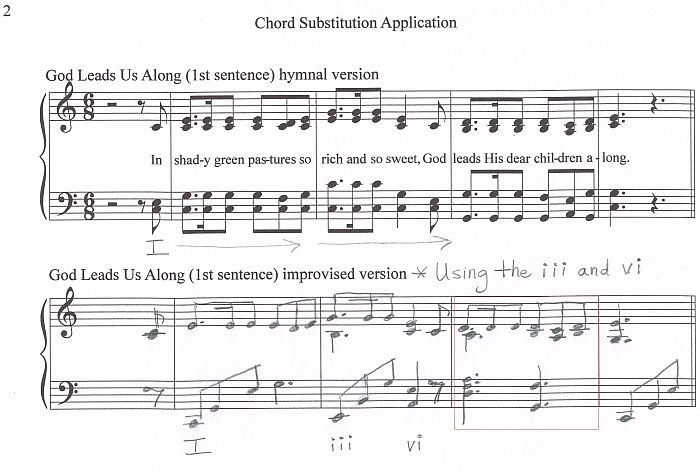
*Click on the following pages to download:
Page one: Chord Substitution Application
Page two: Chord Substitution Application
Tags: chord substitution, chord substitutions, church pianist, congregation, congregational singing
Posted in Accompaniment tips, Chord Substitutions, Chords, congregational singing, Improvising hymns, Miscellaneous tips, Theory | 1 Comment »
![]()









